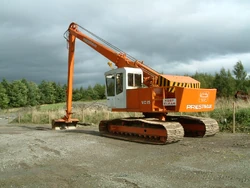
Priestman VC15 Long reach at Threlkeld Quarry
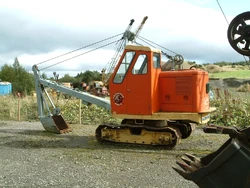
Priestman Cub shovel at Threlkeld quarry 2005
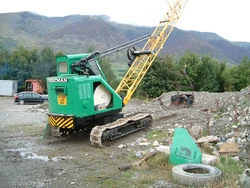
Priestman dragline restored in British Waterways colours
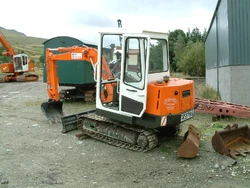
Priestman Mustang at Threlkeld 2005
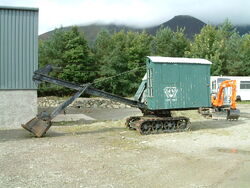
Early Priestman face shovel
Priestman started in Hull in 1876.
The Company was founded by William Dent Priestman (1847-1936) who was a strict Quaker and who worked with his father, at Holdernes Foundry in Hull, and later his brother to Found Priestman Brothers.
The brothers manufactured dredging equipment, cranes and winches. Later the company would become known for building first rope operated then hydraulic excavators.
History
The Priestman story began when William Dent Priestman in 1876, who had founded an engineering firm in Hull six years earlier, was asked to build a winch and grab for work off the west coast of Spain, in an attempt to locate lost gold. Though nothing was ever found, the mechanism that William Dent created was found to be equally effective at dredging mud and silt in docks, rivers and harbours. William set up with his brother to manufacture the new grabs.
By the 1870s William Priestman had developed an interest in the developing technology of the internal combustion engine. William Priestman developed an engine that had a pressurised the fuel tank using an air pump. The outlet from the tank leading to a fuel atomizer which continuously injected warm fuel into a vaporizing chamber heated by exhaust gases, with lamp oil being used as the fuel.[1] (Richard Hornsby & Sons another local company was also building similar engines to the patents of Herbert Akroyd Stuart).
These Patent grabs were soon used at Hull Docks – with such success that they were soon in demand all over the world. Success after success followed, before the firm went into liquidation in 1895.
Restructuring followed, and Priestmans began to shine brightly once more. By the First World War, its cranes were being used to rebuild French villages , and by 1921, a small "ditcher" for field drainage was produced, followed by funding from the Ministry of Agriculture for further developments.
Face shovels, dragline excavators and backactor ditching machines as well as power grabs became the mainstay of the expanding Priestman company.
In 1928, Priestmans produced the first of their "animal-named" excavators. Such names as the Lion, Tiger and Panther would later become synonymous with Priestmans. Early machines were very crude with the driver sitting next to the engine.
The machines an be configured as Draglines, Face Shovel, Bach hoe, Skimmer and Cranes, by changing the Jib / Boom and ancillary equipment.
Work started on their Marfleet base in 1950. It would eventually cover 63 acres in Hull, and by 1963, when the firm embraced hydraulic power, it had long been a household name.
In the 1970s they developed a range of hydraulic excavators. The VC range of dredging machine with long reach booms to replace draglines. his had an innovative sliding counter weight to balance the boom at long reach. These were popular with small sand and gravel pits and with the drainage board and water companies in Lincolnshire for cleaning dykes. They also built special versions on tall pedestals for dock side un-loading duties.
In 1972 the Steels Group - Priestmans parent company was taken over by the expanding Acrow Group. Steels Group also owned the Coles Cranes company and the Neal & Taylor crane companies.[2]
The Priestman division was sold off in 1984 to the near by firm of Sanderson of Skegness in Lincolnshire.
The remaining Acrow Group collapsed in 1985 when the company went into administration and the Crane division, by now slimmed down to one production plant in Sunderland, was picked up by the American crane builder Grove.
The Sanderson Group then got into trouble in the early 1990s and the Priestman operations were sold to another local company RB Cranes following there break up of the Ruston-Bucyrus group. They were then taken over by NEI Group and merged with the Coles Cranes of Sunderland operation and, began building offshore cranes for North Sea oil rig platforms.
Today, what is left of the firm trades in Bradford under new owner, Gardner Denver, the American based compressor and blower manufacturer. No longer are cranes or excavators manufactured.
The replacement parts business became unsustainable after the last Priestman employee retired in 2007. All the drawings and specifications exist. These are all in storage slowly deteriorating with age.
| This article about a place does not specify the country, city or region where it is located. Please help improve it to include this information as Tractor Wiki is viewed by a worldwide audience. You can discuss the issue on the talk page. |
The legacy lives on ?.
| The neutrality of this article is disputed. Please see the discussion on the talk page. Please do not remove this message until the dispute is resolved. |
Model Range
- Crawler cranes & Universal excavators
- Priestman Cub
- Priestman Hydro-Cub - early part hydraulic machine
- Priestman Beaver Mk I 1965 (Hydraulic version of Cub)
- Priestman Hydro-Cub - early part hydraulic machine
- Priestman Lion
- Priestman Panther
- Priestman Tiger
- Priestman Wolf
- Wolf Mk.I
- Wolf Mk.II
- Wolf Mk.III
- Crawler cranes
- Priestman LC 51
- Priestman MC 250
- Priestman MC 300
- Priestman MC 350
- Priestman MC 350 Lion
- Priestman MC 350 HD
- Priestman MC 400
- Priestman Lion 40H
- Priestman Lion 50H
- Priestman Lion 85H
- Hydraulic excavators
- Mustang Mini (Priestman badged Takeuchi model) 3 machines in range.
- Priestman Mustang range
- Mustang 90 Wheeled excavaor
- Mustang 120 Perkins 6.354 / Ford 365 engine option
- Mustang 150 (wheeled version of 120)
- Mustang Swing Shovel - A 120 with 1¼ Cu yd front shovel gear
- Mustang 160 16 ton servo control with Ford engine.
- Mustang 220 22 ton servo control with Perkins V8 / G.M.engine option.
- Mustang 320 - 30+ ton m/c Perkins V8 engine ? (rumoured to be only 4 built)
- Mustang 108 S Ford 365 6 cyl
- Mustang 168 Ford 380 6 cyl turbo.
- Mustang 2-12 (Sanderson) Ford 4 cyl.
- Mustang 2-11 Wheeled version of 2-12 (Sanderson)
- Mustang 2-15 (Sanderson)Perkins 6.354
- Mustang 2-18 (Sanderson)Perkins 6.354
- Priestman VC excavators
- Priestman VC 15 - built from 1982-84 s/n 4100-4185 (85 built by Priestman)
- Priestman VC 15 (Sanderson till 1989)
- Priestman VC 20-15 (Sanderson till 1989 then RB International)
- Priestman VC-20 (Sanderson till 1989 then RB International)
- Priestman VC-30 proto type (Sanderson)
- Industrial cranes
A range of Cranes for fixed industrial dockside and Oil Rig pedestal mounting were built from the 1970s.
Preserved Machines List
- Collection of machines in Adrian Pattersons collection at Threlkeld, Cumbria.
- Cub Mk.1 - 1933 up to the last Mk.6 - 1969
- Wolf
- VC 15 - 1984 machine s/n 4178 fitted with a Perkins A6.354 engine, and 10 roller tracks for riverbank works.[3]
- Priestman 120
- Priestman Mustang 120 - 1979 (2 no.)
- Beaver Mk I of 1965 (S/N A12202) @ Threkeld, fitted with Lister HB4
- S.E. Davis & Son Ltd. have a Cub in their collection, at Astwood Bank Redditch.
Models (scale) / Toys
A number of toy manufactures have included Models of Priestman machines in there ranges going back to the early twentieth century.
- Tri-ang bult model tinplate models from the 1930 of cranes and offered a Priestman Grab to go with the Jones KL44 crane model as optional extra. http://www.triang.nl/cranes.htm (photos)
- add details of other models here please
See also
- List of Construction Plant Manufactures
- Ruston (engine builder)
- Ruston-Bucyrus
- NCK
- NCK Rapier
- Ransomes & Rapier
- Vintage Excavator Trust
- Shows and Meets
- Collections
References
- Classic Plant & Machinery Magazine
- Web site on Coles (see below)
- ↑ Science museum Photos Short history with photo of William Priestman
- ↑ Graces guide - Acrow article
- ↑ CP&M V6 no.12 August 2008
External links
- Site with some Info and photos
- National Archives index of Priestman related material held
- Priestman dredger wreck in Australia - built in 1889, sunk 1893
| ||||||||||||||||||||||||||||||||||||||||||||